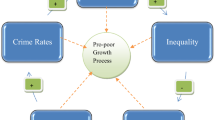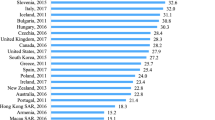Abstract
Household surveys underreport incomes from the upper tail of the distribution, affecting our assessment about inequality. This paper offers a tractable simulation method to deal with this situation in the absence of extra information (e.g., tax records). The core of the method is to draw pseudodata from a mixture between the income empirical distribution and a parametric model for the upper tail, that aggregate to a preestablished top income share. We illustrate the procedure using Peruvian surveys that, as in the rest of Latin America, have displayed a sustained decrease in the Gini index since the 2000s. In a number of experiments, we impose a larger top income share than the one observed in the data, closer to corrected estimates for less egalitarian neighbors (e.g., Colombia and Chile). We find that even though the point estimates of the Gini index are biased, the corrected indices still decrease in time.
Similar content being viewed by others
References
Aaberge, R., Atkinson, A. B., Modalsli, J.: Estimating long-run income inequality from mixed tabular data: Empirical evidence from Norway, 1875–2017. J. Public Econ. 187, 104196 (2020)
Alfons, A., Templ, M., Filzmoser, P.: Robust estimation of economic indicators from survey samples based on Pareto tail modelling. J. R. Stat. Soc. Ser. C (Appl. Stat.) 62(2), 271–286 (2013)
Alvaredo, F.: The rich in Argentina over the twentieth century, 1932-2004. In: Atkinson, A.B., Piketty, T. (eds.) Top Incomes: A Global Perspective, chapter 6, pp 253–298. Oxford University Press, Oxford (2010)
Alvaredo, F.: A note on the relationship between top income shares and the Gini coefficient. Econ. Lett. 110(3), 274–277 (2011)
Alvaredo, F., Assouad, L., Piketty, T.: Measuring inequality in the Middle East 1990-2016: The world’s most unequal region? Rev. Income Wealth 65(4), 685–711 (2019)
Alvaredo, F., Atkinson, A. B., Blanchet, T., Chancel, L., Bauluz, L., Fisher-Post, M., Flores, I., Garbinti, B., Goupille-Lebret, J., Martínez-Toledano, C., et al.: Distributional national accounts guidelines, methods and concepts used in the world inequality database. Technical report (2020)
Alvaredo, F., Londoño Vélez, J.: High Incomes and Personal Taxation in a Developing Economy: Colombia 1993-2010 CEQ Working Paper 12. CEQ Institute, Tulane University (2013)
Amarante, V.: Income inequality in Latin America: A factor component analysis. Rev. Income Wealth 62, S4–S21 (2016)
Anand, S., Segal, P.: Who are the global top 1%? World Dev. 95, 111–126 (2017)
Assouad, L., Chancel, L., Morgan, M.: Extreme inequality: Evidence from Brazil, India, the Middle East, and South Africa. AEA Papers Proc. 108, 119–23 (2018)
Atkinson, A. B.: Top incomes in the UK over the 20th century. J. R. Stat. Soc. Ser. A (Stat. Soc.) 168(2), 325–343 (2005)
Atkinson, A. B.: Measuring top incomes: Methodological issues. In: Atkinson, A. B., Piketty, T. (eds.) Top Incomes Over the Twentieth Century: A Contrast Between Continental European and English-Speaking Countries, chapter 1, pp 18–42. Oxford University Press, Oxford (2007)
Atkinson, A. B., Piketty, T.: Top Incomes: a Global Perspective. Oxford University Press, Oxford (2010)
Atkinson, A. B., Piketty, T., Saez, E.: Top incomes in the long run of history. J. Econ. Lit. 49(1), 3–71 (2011)
Auten, G., Splinter, D.: Top 1 percent income shares: Comparing estimates using tax data. AEA Papers Proc. 109, 307–11 (2019)
Balkema, A. A., De Haan, L.: Residual life time at great age. Ann. Probab. 2(5), 792–804 (1974)
Bee, M.: Estimation of the Lognormal-Pareto distribution using probability weighted moments and maximum likelihood. Commun. Stat. - Simul. Comput. 44 (8), 2040–2060 (2015)
Blanchet, T., Chancel, L., Gethin, A.: How Unequal Is Europe? Evidence from Distributional National Accounts, 1980-2017. WID.World Working Paper 2019/06, World Inequality Lab (2019)
Blanchet, T., Flores, I., Morgan, M.: The weight of the rich: Improving surveys using tax data. WID.World Working Paper 2018/12, World Inequality Lab (2018)
Bourguignon, F.: Appraising income inequality databases in Latin America. J. Econ. Inequal. 13(4), 557–578 (2015)
Burdín, G., De Rosa, M., Vigorito, A., Vilá, J.: Was falling inequality in all Latin American countries a data-driven illusion? income distribution and mobility patterns in Uruguay 2009-2016. Discussion Paper 13070, IZA - Institute of Labor Economics (2020)
Burkhauser, R., Hahn, M., Wilkins, R.: Measuring top incomes using tax record data: A cautionary tale from Australia. J. Econ. Inequal. 13(2), 181–205 (2015)
Burkhauser, R. V., Feng, S., Jenkins, S. P., Larrimore, J.: Recent trends in top income shares in the united states: Reconciling estimates from March CPS and IRS tax return data. Rev. Econ. Stat. 94(2), 371–388 (2012)
Burkhauser, R. V., Hérault, N., Jenkins, S. P., Wilkins, R.: What has been happening to UK income inequality since the mid-1990s? answers from reconciled and combined household survey and tax return data. ISER Working Paper 2016-03, Institute for Social and Economic Research (2016)
Chancel, L., Cogneau, D., Gethin, A., Myczkowski, A.: How Large Are African Inequalities? Towards Distributional National Accounts in Africa, 1990-2017. WID.World Working Paper 2019/13, World Inequality Lab. (2019)
Chancel, L., Piketty, T.: Indian Income Inequality, 1922-2015: From British Raj to Billionaire Raj?. Rev. Income Wealth 65, S33–S62 (2019)
Charpentier, A., Flachaire, E.: Pareto Models for Top Incomes. Technical report (2019)
Clementi, F., Gallegati, M.: Pareto’s law of income distribution: Evidence for Germany, the United Kingdom, and the United States. In: Chatterjee, A., Yarlagadda, S., Chakrabarti, B. K. (eds.) Econophysics of Wealth Distributions, chapter 1, pp 3–14. Springer, Milano (2005)
Cord, L., Genoni, M. E., Rodríguez-Castelán, C.: Overview. In: Cord, L., Genoni, M. E., Rodríguez-Castelán, C. (eds.) Shared prosperity and Poverty Eradication in Latin America and the Caribbean, chapter 1, pp 1–51. World Bank, Washington (2015)
Cowell, F. A., Flachaire, E.: Income distribution and inequality measurement: The problem of extreme values. J. Econ. 141(2), 1044–1072 (2007)
Davidson, R., Flachaire, E.: Asymptotic and bootstrap inference for inequality and poverty measures. J. Econ. 141(1), 141–166 (2007)
De Rosa, M., Flores, I., Morgan, M.: Inequality in Latin America revisited: Insights from Distributional National Accounts. Technical Note 2020/02, World Inequality Lab. (2020)
Deaton, A.: Measuring poverty in a growing world (or measuring growth in a poor world). Rev. Econ. Stat. 87(1), 1–19 (2005)
Díaz-Bazán, T.: Measuring Inequality from Top to Bottom. World Bank Policy Research Paper 7237, World Bank (2015)
Eckerstorfer, P., Halak, J., Kapeller, J., Schütz, B., Springholz, F., Wildauer, R.: Correcting for the missing rich: an application to wealth survey data. Rev. Income Wealth 62(4), 605–627 (2016)
Ferreira, F. H. G., Messina, J., Rigolini, J., López-Calva, L. F., Lugo, M. A., Vakis, R.: Economic Mobility and the Rise of the Latin American Middle Class. The World Bank, Washington (2013)
Flores, I., Sanhueza, C., Atria, J., Mayer, R.: Top incomes in Chile: A historical perspective on income inequality, 1964-2017. Rev. Income Wealth 66(4), 850–874 (2020)
Gabaix, X., Ibragimov, R.: Rank− 1/2: A simple way to improve the OLS estimation of tail exponents. J. Bus Econ. Stat. 29(1), 24–39 (2011)
Gasparini, L.: Different lives: Inequality in Latin America. In: De Ferranti, D., Perry, G. E., Ferreira, F. H., Walton, M. (eds.) Inequality in Latin America and the Caribbean: Breaking with History?, chapter 2, pp 35–71. World Bank, Washington (2004)
Gasparini, L., Cruces, G., Tornarolli, L., Mejía, D.: Recent trends in income inequality in Latin America. Economía 11(2), 147–201 (2011)
Genoni, M. E., Salazar, M.: Steering towards shared prosperity in Peru. In: Cord, L., Genoni, M. E., Rodríguez-Castelán, C. (eds.) Shared Prosperity and Poverty Eradication in Latin America and the Caribbean, chapter 8, pp 269–301. World Bank, Washington (2015)
Hajargasht, G., Griffiths, W. E.: Pareto-lognormal distributions: inequality, poverty, and estimation from grouped income data. Econ. Model. 33, 593–604 (2013)
Herrera, J.: Poverty and economic inequalities in Peru during the boom in growth: 2004-14. In: Carbonnier, G., Campodónico, H., Vázquez, S.T. (eds.) Alternative Pathways to Sustainable Development: Lessons from Latin America, chapter 8, pp 138–173. Brill Nijhoff (2017)
Higgins, S., Lustig, N., Vigorito, A.: The rich underreport their income: Assessing bias in inequality estimates and correction methods using linked survey and tax data. ECINEQ WP 2018-475, ECINEQ (2018)
Ibragimov, M., Ibragimov, R.: Heavy tails and upper-tail inequality: The case of Russia. Empir. Econ. 54(2), 823–837 (2018)
Jenkins, S. P.: Pareto models, top incomes and recent trends in UK income inequality. Economica 84(334), 261–289 (2017)
Kim, N. -N.: Top incomes in korea: update, 1933-2016. Korean Econ. Forum 11(1), 1–21 (2018)
Lakner, C., Milanovic, B.: Global income distribution: from the fall of the Berlin Wall to the Great Recession. World Bank Econ. Rev. 30(2), 203–232 (2016)
Lustig, N.: The ‘Missing Rich’ in Household Surveys: Causes and Correction Approaches. Working Paper 75 Commitment to Equity (CEQ) Institute. Tulane University (2019)
Lustig, N., López-Calva, L. F., Ortiz-Juarez, E.: Declining inequality in Latin America in the 2000s: The cases of Argentina, Brazil, and Mexico. World Dev. 44, 129–141 (2013)
Morgan, M.: Income inequality, growth and elite taxation in Brazil: New evidence combining survey and fiscal data, 2001-2015. Working Paper 165, International Policy Centre for Inclusive Growth (2018)
Novokmet, F., Piketty, T., Yang, L., Zucman, G.: From communism to capitalism: Private versus public property and inequality in China and russia. In: AEA Papers and Proceedings, vol. 108, pp 109–13 (2018)
Paz, P., Urrutia, C.: Economic growth and wage stagnation in Peru: 1998-2012. Rev. Dev. Econ. 19(2), 328–345 (2015)
Piketty, T.: Income inequality in France, 1901-1998. J. Polit. Econ. 111(5), 1004–1042 (2003)
Piketty, T., Saez, E.: Income inequality in the United States, 1913-1998. Q. J. Econ. 118(1), 1–41 (2003)
Piketty, T., Saez, E., Zucman, G.: Distributional national accounts: Methods and estimates for the United States. Q. J. Econ. 133(2), 553–609 (2018)
Piketty, T., Yang, L., Zucman, G.: Capital accumulation, private property, and rising inequality in China, 1978-2015. Amer. Econ. Rev. 109(7), 2469–96 (2019)
Reed, W. J.: The Pareto law of incomes: An explanation and an extension. Physica A: Stat. Mech. Appl. 319, 469–486 (2003)
Reed, W. J., Jorgensen, M.: The double Pareto-lognormal distribution—a new parametric model for size distributions. Commun. Stat. - Theory Methods 33(8), 1733–1753 (2004)
Ruiz, N., Woloszko, N.: What do household surveys suggest about the top 1% incomes and inequality in OECD countries? OECD Economics Department Working Paper 1265, OECD (2016)
Saez, E., Zucman, G.: Trends in US income and wealth inequality: Revising after the revisionists. Working Paper 27921, National Bureau of Economic Research (2020)
Smith, M., Yagan, D., Zidar, O., Zwick, E.: Capitalists in the twenty-first century. Q. J. Econ. 134(4), 1675–1745 (2019)
Smith, M., Zidar, O. M., Zwick, E.: Top wealth in America: New estimates and implications for taxing the rich. Working Paper 29374, National Bureau of Economic Research (2021)
Stampini, M., Robles, M., Sáenz, M., Ibarrarán, P., Medellín, N.: Poverty, vulnerability, and the middle class in Latin America. Latin Amer. Econ. Rev. 25(1):Article 4 (2016)
Székely, M., Mendoza, P.: Declining inequality in Latin America: Structural shift or temporary phenomenon? Oxf. Dev. Stud. 45(2), 204–221 (2016)
Vermeulen, P.: How fat is the top tail of the wealth distribution?. Rev. Income Wealth 64(2), 357–387 (2018)
Winkelried, D., Torres, J.: Economic mobility along the business cycle. the case of Peru. Appl. Econ. 51(18), 1894–1906 (2019)
Yamada, G., Castro, J. F., Bacigalupo, J.: Desigualdad monetaria en un contexto de rápido crecimiento económico: El caso reciente del Perú. Rev. Estud. Econ. 24, 65–77 (2012)
Author information
Authors and Affiliations
Corresponding author
Additional information
Publisher’s note
Springer Nature remains neutral with regard to jurisdictional claims in published maps and institutional affiliations.
We are indebted to Gustavo Yamada for insightful discussion. We would also like to thank Marco Terrones, Javier Torres, the editor Daniel Waldenström and two anonymous referees for very useful comments. The financial support of the Research Center of Universidad del Pacífico (Project PPA 2018) is gratefully acknowledged. We alone are responsible for the views expressed in this paper and for any remaining errors.
Rights and permissions
About this article
Cite this article
Winkelried, D., Escobar, B. Declining inequality in Latin America? Robustness checks for Peru. J Econ Inequal 20, 223–243 (2022). https://doi.org/10.1007/s10888-021-09523-5
Received:
Accepted:
Published:
Issue Date:
DOI: https://doi.org/10.1007/s10888-021-09523-5




